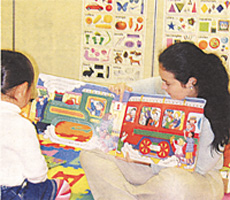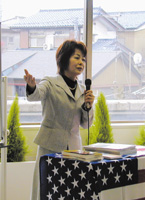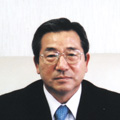Trends in Japanese Alternative Education
Back to Contents of Issue: June 2005
|
|
|||||||||||||||
|
by Terrie Lloyd |
|||||||||||||||
 In 2001, the Japan Free School Association was established to bring together over 240 "free schools" (jiyu gakko), which lie outside of the Education Ministry's jurisdiction and which specialize in teaching kids who have adjustment problems and can't attend a regular school. From 1994, the Education Ministry started recognizing these schools, and today they are teaching more than 130,000 three- to fifteen-year-olds. Thanks to the Education Ministry's recognition, graduates from free schools can now
sit for entrance examinations of national universities. In 2001, the Japan Free School Association was established to bring together over 240 "free schools" (jiyu gakko), which lie outside of the Education Ministry's jurisdiction and which specialize in teaching kids who have adjustment problems and can't attend a regular school. From 1994, the Education Ministry started recognizing these schools, and today they are teaching more than 130,000 three- to fifteen-year-olds. Thanks to the Education Ministry's recognition, graduates from free schools can now
sit for entrance examinations of national universities.
A mid-sized but fast-growing player in the field is the Nihon Gakuin (Japan International Institute -- NKG for short), based in Kashiwa, Chiba. NKG has about 200 students, children who for emotional or other reasons can't attend standard public schools. The school is run by founder Toshiaki Furui, and currently offers a full curriculum for kids aged 10 years and older. The ijime (bullying) problem in Japanese public schools is well known and has resulted in the recent phenomenon of hikikomori (stay-at-home) kids. Furui estimates that about 150,000 children, out of a primary -- middle school age population of approximately 10MM children, skip school more than 30 days a year. While this is only 1.5% of the total and so doesn't sound particularly serious, we should remember that this figure is only for primary and junior high schools. Since senior high school attendance is not compulsory in Japan (although 90 percent of middle school students continue their education), the numbers of kids cutting classes on a regular basis and for maladjustment reasons is probably much higher. When Furui started NKG in 1995, the problem of truancy and the inability of some children to fit into the rigid Japanese school system were beginning to be recognized by the Education Ministry. Back then, Furui was a trailblazer and fighter and had to overcome resistance by both government regulators as well as families who didn't want to face the problem. The turning point came in the late 90s, when the Education Ministry started to confront the issue of the spiraling number of school truants and realized the necessity for an alternative system. Today things are much better, and teachers at local government-run schools across the nation now willingly refer problem children to free schools such as NKG. Attending NKG For a new student at NKG life starts with a counseling session. Accompanied by mom and dad, both student and parents are asked to identify what they want the student to achieve. The objective is to gain a buy-in from all parties, to maximize commitment and the chances of success. Mom might be asked to promise to listen more to the child's fears and problems; dad might be asked to be home earlier and to play catch or help with homework; and, of course, the student commits to come to school regularly and to actually try to improve his or her habits and lifestyle. From the counseling session, NKG can tell whether the child is simply misunderstood, ipso facto, under pressure, or whether the child suffers from a deeper disorder or psychosis. The temptation, even at free schools, is to turn away kids with deep-seated problems and to send them to a medical specialist. In theory, this sounds reasonable, but unfortunately Japan's capabilities in dealing with childhood psychiatry are not very advanced and heavy medical prescriptions are usually part of the fix. The kids may become more manageable, but can be lost to institutional care in the process. NKG's approach is to not give up on a child until it is absolutely clear he or she is beyond their help. Furui is adamant on this point and believes that every child wants to re-engage with life. As a result, NKG's counselors spend lots of time just listening to their charges. After being exposed to a good listening partner, Furui reckons almost all the kids who have gone through his school are able to emerge from their shells. Once at school, kids struggling back to normalcy are given a range of therapies -- most of which revolve around improving the child's communication skills and self-confidence. Music is one popular therapy, since it seems to let kids make the instrument "talk" on their behalf. Another therapy is a hands-on activity -- such woodcraft, art, local travel and foreign language study -- all things that make children feel that there is something special they can do. These activities are common elements in other free schools around Japan, too. Although NKG uses counselors intensively, Furui tells us that in some ways the school has to compromise. Again, he points out that Japan is still sadly lacking in this field and has no national qualifications that recognize counseling as a medical discipline. As a result, Furui draws both on people with a clinical psychology background, and older people without professional training but with extensive community support and youth counseling experience. Sending your child to a non-public alternative school is never inexpensive. As parents with children in international schools know, the base fees can run between ¥1.5m and ¥2.5m per child per year. However, Furui pushes prices down such that NKG is affordable by ordinary middle class families. Right now he charges about ¥1, 000,000 per annum, about the same price as for a regular Japanese private high school.  Revisiting Hikikomori
Revisiting HikikomoriA problem in handling children who, as a result of marginal psychological problems, refuse to attend school is that Japan has no system to coerce parents into doing something about it. In the absence of evidence of child abuse, the legal and child welfare systems leave the parents alone. The best a concerned teacher can do is to visit the home and interview the child and parents. If there is no cooperation, then the teacher can turn to the Education Ministry -- which tries to offer counseling. This is a poor way to reach troubled kids, especially those suffering from hikikomori. Besides refusal to attend school, what are the other hikikomori symptoms? They can be severe. In 2002 the BBC interviewed a 17-year-old boy who moved into the family kitchen at the age of 14 and wouldn't come out again. He wouldn't let family members into the kitchen -- causing them to have to build a new one elsewhere in the house -- used the toilet next to the kitchen, and took a bath once every six months or so. Other symptoms include fear of using public transport, toilets, or tableware other than those at home. In such cases, Education Ministry counselors try telephone counseling to help kids return to a normal balance. But, as Furui says, "If you can get a kid on the phone for counseling, then the kid does not have an acute problem. The ones we worry about are those kids who are just not reachable by normal means." No one really knows the origin of the present epidemic of hikikomori. While it is easy to blame the system, the schools, or soft-hearted parents, Furui says that in his experience parental neglect is not the cause. In fact, it is the mother who generally approaches NKG. He says that the normal process of children finding a free school is that mom realizes there is a problem, and then visits the child's school and discovers the depth and extent of the maladjustment. From there she will try to get child counseling, and later try alternative schools -- such as Furui's NKG or in more extreme cases, disciplinary schools. This latter type of school is usually an avenue of last resort, especially after the 1990's scandal at the Totsuka Yachting School in Mihama, in which some instructors, including the founder, were charged with the deaths of several children boarding at the institution. Furui thinks that one possible reason why the number of cases of hikikomori has swollen to more than 1 million kids and young adults is because kids get it too good at home. As he points out, an air-conditioned bedroom with broadband, TV, and regular meals is more fun than attending a 30-year-old concrete pit that passes as a school but which lacks space, lighting, cool air, modern toilets, friendly playmates, and pretty much any other humane convenience. Another possible reason for the increase is that the older children themselves are now hearing via the Internet and other media that in fact there are little or no consequences for being a truant. This situation of powerlessness has arisen simply because there are no laws covering kids who won't go to school. Based in the historical judicial stance that family problems are the province of dad rather than the court, truancy falls outside the purview of the law. Perhaps this will change as delinquency increases judges' case loads.  The Foreign connection
The Foreign connectionOne potential solution for teenagers suffering from hikikomori has been to send them overseas so that they can immerse themselves into a totally new environment. This is often parents' solution of choice because of the perception that life in Western countries is freer and less mentally stressful. Whether or not the presumptions are correct, overseas training schools are quite popular -- despite their expense. One which gained unwanted notoriety in the press in 2003 was the Columbus Academy in Auckland, New Zealand -- set up specifically to look after Japanese kids who had adjustment problems in Japan. The Columbus Academy would have remained an obscure outpost for disturbed Japanese kids if nine of the students had not beat to death a classmate. But for most parents, and especially those living in places like Kashiwa, the annual cost of ¥3MM (US$30,000) to send your kids overseas is not an option. Keeping this in mind, Furui nevertheless believes that a change of pace and culture can indeed help hikikomori kids recover. He has seen first-hand how lively foreign instructors can open up new vistas for his 200 troubled charges. He started bringing foreign teachers of English into the school in 2000. The reactions of students were as he'd hoped, with many kids emerging from their shells and interacting with their new role models. Furui tells us of a case of one young male student who upon graduation was inspired to travel in China, thanks to his exposure to a teacher from that country. Furui also brings teachers from the USA and Australia. English for Toddlers Ever since he was a child, Furui has dreamed of creating a business combining education and his fascination for things foreign -- a fascination he picked up as a child watching airplanes leave contrails in Chiba skies. While his experiments with having English teachers come in to inspire troubled youth are having a positive effect, the main limiting factor on the business side is that you can only allocate so many teachers to interact with 200 students. Thus, now that he has established a source of teachers, from China, the USA, and Australia, Furui wants to apply that pipeline to a different demographic of students: preschoolers. One day back in 2003, Furui was brainstorming with his staff about how to accelerate the numbers of his free school. He realized that rather than solely focus on kids with problems, which will always be in the minority, perhaps they should take the same values and capabilities to a larger demographic -- preschoolers. They decided that they would use the same selling points they had established for the free school -- namely, that the new day care operation had to be low-cost, full-time, staffed with caring people, and involve English. In particular, Furui felt that while there is a boom in teaching English to Japanese youngsters, exposure just two to three times a week for an hour each time is not enough to establish a language foundation. Therefore, he decided to run a full-time English day care center for Japanese kids -- surprisingly, one of the few of its type in Japan so far. While an English-only kindergarten may not seem remarkable to Tokyo-based readers, remember that Furui is located in a Chiba bedroom town where you can probably count the number of foreigners living in the area on one hand. In early 2005, he had his staff put together a trial program for the new preschool, which has been named Puppy. His staff advertised the school to mothers in local housing projects and apartment buildings. The response was overwhelming -- within a week they had filled their first intake quota of 20 full-time kids, at a price of ¥40,000 per child per month. This price is actually very reasonable, and compares favorably with the ¥50,000 plus for a full-time day care center run by the local city. Due to the unexpectedly good response, Furui's team are working on another class of 20 kids and reckon they'll have it up and running within weeks of the first class due in September 2005. At the same time, talk about his new school has started to do the rounds and he has been getting enquiries from other towns and cities wanting to establish similar schools. If all goes well for Puppy in September, Furui could have an exciting franchise opportunity on his hands. That is exactly where he is headed: he wants to build a chain of day care centers in northeastern Kanto over the next three years. While it is the mothers that bring troubled children in for the free school, for the toddlers, Furui reports, fathers play a major role. That is surprising because fathers are seldom home during the children's waking hours. However, Furui has found that many salaried workers in the Kashiwa bedroom town are finding the tough economy is creating a glass ceiling at their companies and due to their lack of English they are unable to get that all-important international experience needed to rise to the top ranks of management. As a result, dads in the neighborhood want to ensure that their kids have a better career chance, and they see English as the passport for getting there. One project Furui is working on to help Chiba kids become bilingual is that of sending four- and five-year olds with adventurous mothers (who will go with them) on extended homestays overseas. Furui has long felt that full immersion is the most effective way to pick up a language, and already the trend of Korean and Chinese families sending mom and one or more kids to Australia or Canada has become established. Like many, Furui thought that Japanese moms wouldn't want to take the personal risk of moving to another country for a while; however, he changed his mind after meeting a mother last year who lived with her two children in Australia for two years before returning to put them back into a regular Japanese primary school. She convinced him that not only do the kids get a strong language foundation, but that it doesn't take long for the kids to readjust to the Japanese school system, as long as the whole adventure takes place before they are seven or eight. Furui notes that there has to be a two-year separation between dad and mom and the kids. But given the prevalence of dads already working away from the family, he thinks the idea will be readily accepted. To this end, he is establishing a network of schools and homestay providers who will help him when the program is launched. Plans for Growth Given the strong response for the first round of toddler day care classes in English, as well as the anticipated 10 percent yearly growth in demand for alternative education, Furui has ambitious plans for the future. He has already purchased an eight-acre (10,000-tsubo) piece of land in Chiba and plans the construction of student dormitories with a capacity of 4,000 kids. He believes that he can grow his school empire to around ¥3bn (US$30m) in sales over the next 3 years, covering at least 10 cities in northern Kanto. To reach this target he is creating a private offering to investors interested in a piece of the Japanese private education market. He plans to raise around ¥1bn (US$10m) towards the end of the year, after the currently planned preschools are established and running. He is happy to entertain foreign investment and would welcome a tie-up with a fund or school looking for opportunities in Japan. Given that Kumon Institute, which had humble beginnings back in July 1958, is now a ¥63bn (US$630m) company with 26,200 learning centers and 3.6m students around the globe, it could be that NGK has the potential to track a similar trajectory. JI ***** Contact details : Nihon Gakuin CEO : Toshiaki Furui Address : 3-9-3 Akebono, Kashiwashi, Chiba 277-0841, Japan Web : http://www.jia-puppy.jp Email : ozaki@jia-puppy.jp
|
|||||||||||||||
Note: The function "email this page" is currently not supported for this page.






